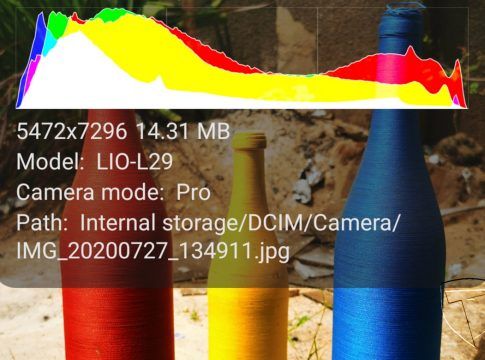Many people wonder the difference between RAW files and JPEG when it comes to photography and the best camera you will ever have is the one you currently have right now in your smartphone if can support it. So, I figured a few colorful (RYB) bottles may simplify things using my Huawei Mate 30 Pro. Read on.
It should be noted that shooting RAW files is mainly reserved for high end smartphones it a common sight in most mirrorless and DSLR cameras that allow you to shoot either JPEG files, RAW files, or both at the same time. Newbies at photography always wonder how the file format fits into the post-production process.
JPEG
A JPEG file can be categories as a fully cooked meal, image that your camera fully develops, and processes the moment you take the shot. Most cameras have a menu where you can pre-adjust settings like color, sharpness, clarity, and so forth before you take your shot. Once those parameters are set, the camera will apply these settings to the final JPEG before it’s saved to the internal memory.
In order to keep the file size down and to make the file more compatible, your camera throws out some of the extraneous color data and other information before it provides you with the image. Once thrown away, that sensor information is lost forever.
ALSO READ: Making a case for Google Play Store data bundles in Uganda
JPEG files can be read/opened by almost every software application available today for post-processing work like cropping and exposure adjustment. However, once you do so, and then make those adjustments and save your image back as a new JPEG file, it will result in a generation loss in terms of quality. Remember, from the time you first took the shot, your camera’s initial image settings (sharpness, color, etc.) were already baked into the final JPEG image.
RAW
Unlike a JPEG, a RAW file is not an image at all, but smartphones will always present it to you as an image. It is, put simply, a blob of binary data that represents what your camera’s sensor recorded at the moment you took the shot. A real RAW file will need software such as Lightroom or Capture One that can understand how to read and convert this file of data into something that you can see, edit, and often share on social media or deliver to clients.
In terms of file size, a RAW file is also a lot larger than a JPEG file. That’s because it’s containing all of the data straight from the camera’s image sensor. But it also contains other information as well. For fun, let’s compare it to a three RED, BLUE and YELLOW bottle. Sure, why not?
JPEG vs. RAW
So, given the complexity and often extra time and storage space needed for handling RAW files, should you bother shooting in that format? Why not just use JPEG since they are most compatible and oftentimes are exactly the shot you want?
Unless you have very specific reasons for only shooting in RAW, then I would strongly suggest that you always shoot in Jpeg format on your smartphone. In fact, I go a step further. I always shoot, no matter what, in both RAW and JPEG. I propose three reasons for this:
1. More Sensor Data to Work With
There’s just more sensor data in RAW files to work with when editing your photos. One of the most important reasons for shooting RAW is to retain color information. For examples of this advantage, as well as highlight/shadow/color recovery, see the video that accompanies this article that will demonstrate this.


2. You Will Get Better
As you develop your skills as a mobile photographer, you will gain a more critical eye over what you shoot, and you will want to sometimes revisit shots that you’ve taken in the past. Having RAW files, with all your camera’s sensor information, will allow you to revisit your shots and give you the best possible quality image to apply your new skills to processing.
The Price of Shooting RAW?
RAW files accumulate up a lot more hard drive space than JPEG files, no doubt about that. Additionally, they are more processor-intensive, require more specific software and post-production workflows, and are generally slower to share on social media.
For some photographers, speed is the name of the game. And having JPEG files is the fastest possible route between shooting and the handoff. Also, for high-speed action burst shots, your camera will often handle burst rates faster with JPEG files than it would with RAW files.
Lastly, RAW processing is interpreted by the individual software used to develop the files. For example, a Fujifilm RAW file will look different in Lightroom than it will in Capture One. Additional editing is often needed to get exactly the look you want.


